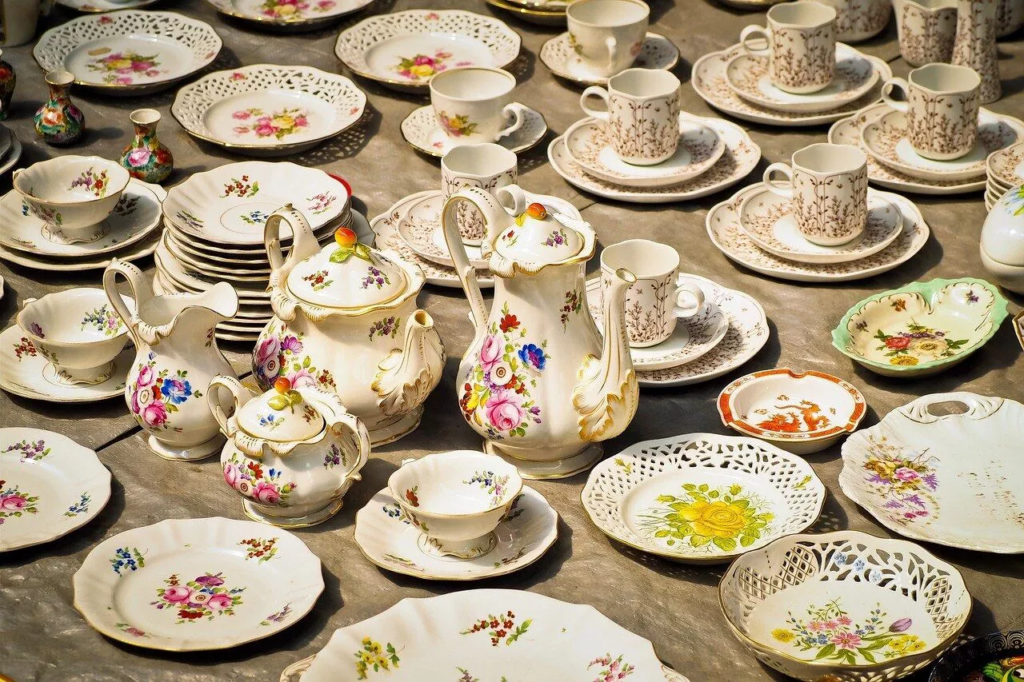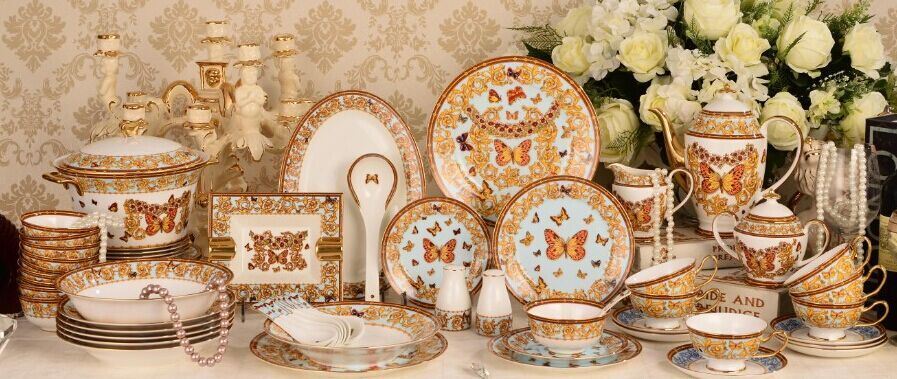Crockery, a term that often conjures up images of plates, bowls, and cups, is an essential part of our dining experience. But what exactly is crockery, and why does it matter? In this article, we’ll dive deep into the world of crockery, exploring its history, types, materials, care tips, and cultural significance. Whether you’re a culinary enthusiast or enjoy a well-set table, there’s something for everyone in this guide.
What is Crockery?
Crockery refers to the ceramic or stoneware dishes, plates, bowls, cups, and other tableware used for serving and eating food. The term is often used interchangeably with “dinnerware” or “tableware,” but it generally excludes glassware and cutlery. Crockery has been used for thousands of years and serves both functional and aesthetic purposes in our daily lives.
The Importance of Crockery
Crockery plays a crucial role in our dining experiences. Not only does it hold and serve our food, but it also contributes to the overall atmosphere of a meal. Imagine a beautifully set dinner table adorned with elegant plates and delicate cups. It elevates the experience, making even a simple meal feel special. Moreover, crockery can reflect cultural traditions and personal styles, allowing us to express our identities through our choices.
A Brief History of Crockery

The history of crockery is as rich as the food we serve on it. Let’s take a journey through time to understand how crockery has evolved.
Ancient Origins
The use of crockery dates back to ancient civilizations. Archaeological findings suggest that the earliest forms of crockery were made from clay and fired in kilns, resulting in durable and heat-resistant vessels. The Chinese are credited with creating the first true porcelain during the Tang Dynasty (618–907 AD). This innovation revolutionized crockery, making it both beautiful and functional.
Middle Ages and Renaissance
During the Middle Ages in Europe, stoneware and earthenware became popular. These materials were sturdy and often featured intricate designs. The Renaissance brought about a revival of artistic expression, and crockery began to showcase exquisite hand-painted designs. Fine china emerged as a luxury item, often reserved for the elite.
Industrial Revolution
The Industrial Revolution in the 18th and 19th centuries marked a significant turning point for crockery production. Advances in manufacturing techniques allowed for mass production, making crockery more accessible to the general public. Companies like Wedgwood and Spode became household names, and decorative styles diversified dramatically.
Modern Era
Today, crockery comes in various materials, designs, and functionalities. From traditional hand-painted pieces to contemporary minimalist designs, the options are virtually limitless. With the rise of e-commerce, consumers can now access crockery from around the world, allowing for unique and personalized dining experiences.
Types of Crockery
Crockery can be classified into several categories based on its use and materials. Let’s explore the different types of crockery commonly found in households today.
Dinnerware Sets
Dinnerware sets typically include plates, bowls, and cups designed for serving meals. They come in various styles, from classic white porcelain to colorful stoneware. Some popular dinnerware sets include:
- Formal Dinnerware: Often made of fine china, these sets are designed for special occasions. They feature intricate designs and are usually more delicate.
- Casual Dinnerware: Made from durable materials like stoneware, these sets are perfect for everyday use. They come in various colors and patterns, making them suitable for casual dining.
Serveware
Serveware consists of larger pieces designed for presenting and serving food. Common types of serveware include:
- Serving Platters: These large, flat dishes are ideal for presenting main courses, appetizers, or desserts.
- Serving Bowls: Typically deeper than regular bowls, serving bowls are perfect for salads, pastas, and side dishes.
Bakeware
Bakeware is specifically designed for cooking and baking. Common bakeware items include:
- Casserole Dishes: These oven-safe dishes are perfect for baking casseroles, lasagna, and other hearty meals.
- Baking Sheets: Flat trays used for baking cookies, pastries, and other baked goods.
Specialty Crockery
In addition to the main categories, there are various specialty crockery items designed for specific purposes:
- Coffee and Tea Sets: These sets usually include cups, saucers, and a teapot or coffee pot. They are often beautifully designed for enjoying hot beverages.
- Dessert Plates: Smaller than dinner plates, dessert plates are perfect for serving sweet treats after a meal.
Materials Used in Crockery
Crockery can be made from various materials, each offering unique characteristics and benefits. Let’s delve into some of the most common materials used in crockery production.
Porcelain
Porcelain is a type of ceramic known for its strength, durability, and translucence. It is made from a refined clay called kaolin, which is fired at high temperatures. Porcelain crockery is often elegantly designed and is suitable for both everyday and formal use.
Stoneware
Stoneware is a dense, durable ceramic that is fired at high temperatures, making it chip-resistant and suitable for both oven and microwave use. It often has a rustic appearance and is available in various colors and finishes. Stoneware is perfect for casual dining and everyday use.
Earthenware
Earthenware is a type of pottery made from natural clay. It is fired at lower temperatures than porcelain and stoneware, resulting in a porous material that is more prone to chipping. However, earthenware is often beautifully glazed and comes in vibrant colors, making it popular for decorative purposes.
Bone China
Bone china is a type of porcelain that contains bone ash, giving it a unique translucence and strength. It is lightweight and delicate, making it an excellent choice for formal dining. Bone china is often more expensive than other materials due to its craftsmanship and quality.
Melamine
Melamine is a type of plastic that is highly durable and lightweight. It is often used for outdoor dining and casual settings, as it is shatter-resistant and easy to clean. Melamine crockery comes in a variety of colors and patterns, making it a popular choice for families with children.
Choosing the Right Crockery
When it comes to selecting crockery, personal preference and lifestyle play significant roles. Here are some factors to consider when choosing the right crockery for your home.
Style and Design
Crockery comes in a myriad of styles, from classic and elegant to modern and minimalist. Consider your existing kitchen and dining decor when choosing crockery. A cohesive look can elevate your dining experience.
Functionality
Think about how you will use your crockery. If you frequently host large gatherings, consider durable stoneware or melamine for casual dining. If you enjoy formal dinner parties, invest in fine china or porcelain for an elegant touch.
Size and Storage
Consider the size of your kitchen and storage space when choosing crockery. Opt for stackable designs to save space in cabinets. Also, think about how many place settings you need to accommodate your family and guests.
Budget
Crockery is available at various price points. While it’s tempting to splurge on high-end items, there are plenty of affordable options that offer both quality and style. Determine your budget beforehand to make informed decisions.
Caring for Your Crockery
Proper care and maintenance are crucial for ensuring the longevity of your crockery. Here are some essential tips to keep your crockery in excellent condition.
Cleaning
- Hand Washing: While many crockery items are dishwasher-safe, hand washing is gentler on delicate pieces. Use mild dish soap and a soft sponge to avoid scratches.
- Dishwasher: For dishwasher-safe crockery, place items securely on the top rack to prevent chipping or cracking. Avoid overcrowding the dishwasher to allow for proper cleaning.
Storing
- Stacking: When stacking plates, place a soft cloth or paper towel between each piece to prevent scratching.
- Storage: Store crockery in a cool, dry place away from direct sunlight to prevent fading or discoloration.
Avoiding Temperature Shock
- Gradual Temperature Changes: Avoid sudden temperature changes, as they can cause cracking. For example, don’t place a hot dish directly into cold water.
The Cultural Significance of Crockery
Crockery is more than just functional; it holds cultural significance across various societies. Let’s explore how different cultures use crockery in their culinary traditions.
Asian Cuisine
In many Asian cultures, crockery plays an integral role in the dining experience. For instance, Japanese cuisine often features beautifully crafted ceramic dishes, enhancing the visual appeal of each meal. In Chinese culture, sharing food from communal serving platters is a traditional practice, fostering a sense of togetherness.
Mediterranean Traditions
Mediterranean countries often use vibrant, hand-painted crockery, reflecting the region’s rich culture and history. In Spain, traditional tapas are served on small plates, allowing for a shared dining experience that encourages conversation and community.
Western Dining
In Western cultures, formal dining often involves elaborate place settings, including multiple pieces of crockery for various courses. The use of fine china during special occasions is a long-standing tradition, symbolizing elegance and sophistication.
DIY Crockery Projects
If you’re feeling creative, why not try your hand at making your own crockery? Here are some fun DIY ideas to get you started.
Hand-Painted Plates
Transform plain white plates into unique masterpieces by hand-painting designs using ceramic paint. Allow them to dry and cure according to the paint’s instructions for a personal touch on your dinner table.
Custom Mug Designs
Use porcelain markers to create personalized mugs. Whether you want to add a name, quote, or design, these custom mugs can make excellent gifts or memorable keepsakes.
Upcycled Crockery Planters
Old or chipped crockery can find new life as planters. Use teacups, bowls, or even plates to create charming mini gardens. Simply add potting soil and your favorite plants for a unique decorative touch.
Conclusion
Crockery is much more than mere dishes; it is a reflection of our culture, a means of artistic expression, and an essential component of our dining experience. From its rich history to the diverse materials and styles available today, crockery continues to evolve while remaining a fundamental aspect of our daily lives.
Whether you are setting the table for a casual family dinner or a formal gathering, the right crockery can enhance the ambiance and create lasting memories. By understanding the different types, materials, and care methods, you can make informed choices that suit your lifestyle and taste.




